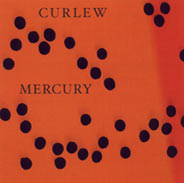
Curlew
Mercury
(Cuneiform)
Maybe
a bit overrated at the times of their connection to trendy names like Bill
Laswell and Fred Frith in his New York period – not to mention the (so called)
"Knitting Factory Sound", the work of the ever-changing collective
called Curlew seems to be quite underrated, almost forgotten. But their catalogue
is solid, from the album North America (1985), recently re-released on CD,
with J. Pippin Barnett’s highly personal drums (what happened to him?), the
cello and the compositions of the sadly departed Tom Cora and the hybrid saxophone
approach – part free, part r’n’b – of their primus inter pares, George Cartwright;
we also have Bee (1991), with Davey Williams on guitar; and their atypical
song album, A Beautiful Western Saddle (1993), with very fine vocals by Amy
Denio. There are those who say that the real story of the group ends here.
I beg to differ. Just listen to Fabulous Drop (1998), with the contrasting
playing styles of Williams and Chris Cochrane and the agile and versatile
Ann Rupel/Kenny Wolleson rhythm axis.
But
I have to confess that I was more than a bit surprised by the approach the
group chose to pursue on Meet The Curlews (2002), an album whose mediocrity
I was absolutely unprepared for, and whose only redeeming grace was Davey
Williams’s guitar. The main problem (I think) being that George Cartwright’s
compositions have more in common with a "club aesthetic" than architecture
– in other words, he’s not Wayne Horvitz – and so they really need musicians
whose musical language (and instrumental "pronunciation") keeps
them from sounding mundane and ordinaire. Which is exactly what happened on
Meet The Curlews: if Fred Chalenor’s bass was as solid as was expected, Bruce
Golden’s drums and Chris Parker’s keyboards (mainly a ho-hum acoustic piano)
went towards a kind of mild acoustic jazz we’ve heard a thousand times before.
Mercury
is their new album – no Williams here, we have Dean Granros on guitar. Is
the new one any better? I think so, even if the group seems to have traded
the acoustic jazz of their previous effort for a kind of electric fusion sporting
an angry guitar and a lead synthesizer sound (the one with both oscillators
in "sync" mode) that’s not any less dated; a type of fusion that
– given the times – is not likely to provide them with any visibility or success.
The really strange thing is that the best part of the album is the second
half – the one that I think not too many people will bother to listen to (the
second track, Funny Money, is really a bit too much). There Is has a nice
theme and an intelligent development, the Chalenor-penned Ludlow manages to
sound fresh (and makes good use of a simple piano/bass interlude), Small Red
Dance (with a guitar sounding a bit like Clapton in his Cream days) is at
least funky and the final Song Of The New uses the bottleneck to good effect.
Let’s hope for their next album.
Beppe
Colli
©
Beppe Colli 2004
CloudsandClocks.net
| Jan. 3, 2004


